Regulation and Governance: A Critical Analysis
VerifiedAdded on 2020/11/12
|15
|4710
|251
AI Summary
This assignment provides a comprehensive analysis of regulation and governance in the UK, covering topics such as dispute resolution, ombuds services, good government, and workplace health and safety standards. It also examines the role of parliament sovereignty, the process of bill becoming law, and the differences between incorporated and unincorporated businesses. The assignment draws on various sources, including academic articles, reports, and online resources, to provide a nuanced understanding of governance in the UK.
Contribute Materials
Your contribution can guide someone’s learning journey. Share your
documents today.

BUSINESS LAW
Secure Best Marks with AI Grader
Need help grading? Try our AI Grader for instant feedback on your assignments.
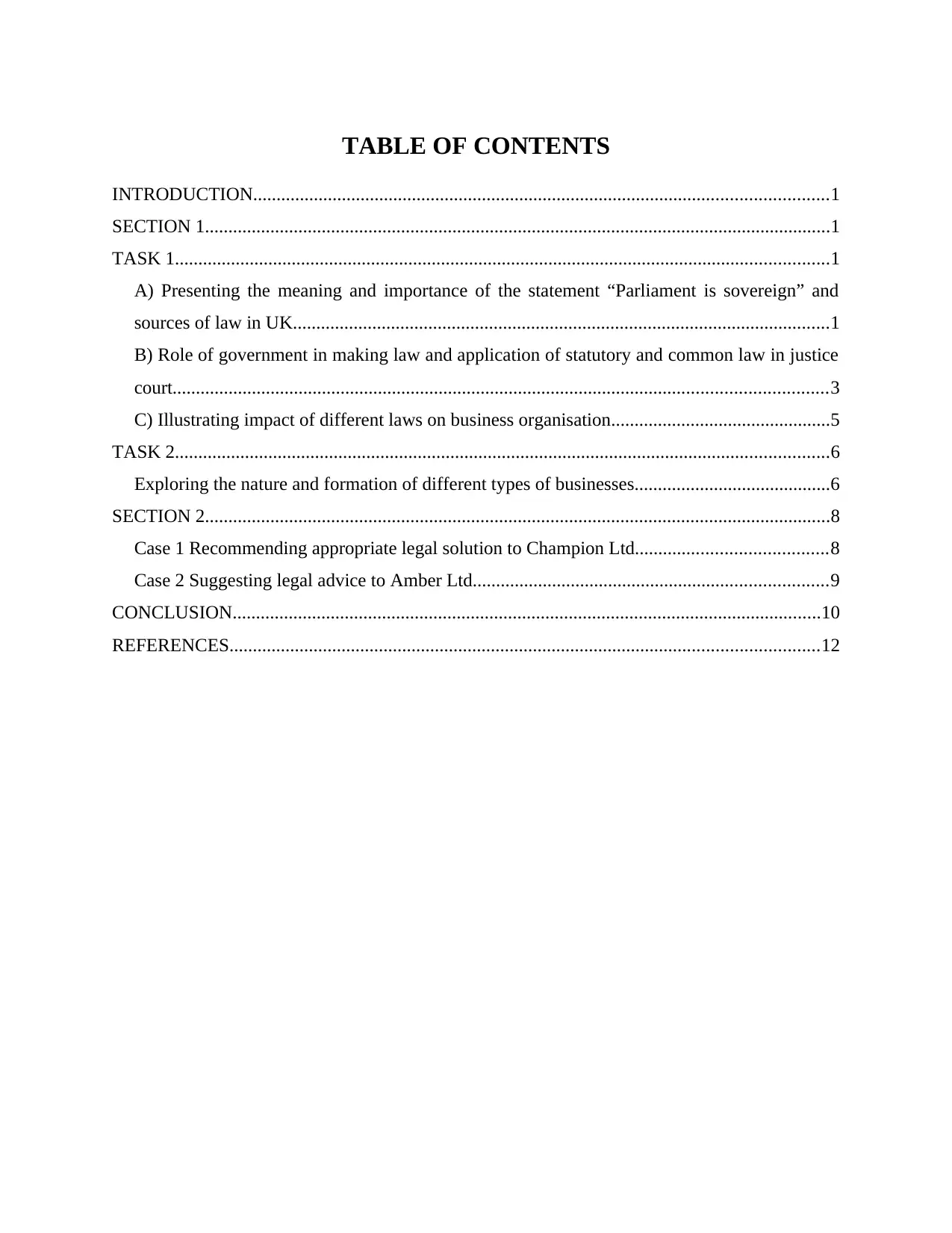
TABLE OF CONTENTS
INTRODUCTION...........................................................................................................................1
SECTION 1......................................................................................................................................1
TASK 1............................................................................................................................................1
A) Presenting the meaning and importance of the statement “Parliament is sovereign” and
sources of law in UK...................................................................................................................1
B) Role of government in making law and application of statutory and common law in justice
court............................................................................................................................................3
C) Illustrating impact of different laws on business organisation...............................................5
TASK 2............................................................................................................................................6
Exploring the nature and formation of different types of businesses..........................................6
SECTION 2......................................................................................................................................8
Case 1 Recommending appropriate legal solution to Champion Ltd.........................................8
Case 2 Suggesting legal advice to Amber Ltd............................................................................9
CONCLUSION..............................................................................................................................10
REFERENCES..............................................................................................................................12
INTRODUCTION...........................................................................................................................1
SECTION 1......................................................................................................................................1
TASK 1............................................................................................................................................1
A) Presenting the meaning and importance of the statement “Parliament is sovereign” and
sources of law in UK...................................................................................................................1
B) Role of government in making law and application of statutory and common law in justice
court............................................................................................................................................3
C) Illustrating impact of different laws on business organisation...............................................5
TASK 2............................................................................................................................................6
Exploring the nature and formation of different types of businesses..........................................6
SECTION 2......................................................................................................................................8
Case 1 Recommending appropriate legal solution to Champion Ltd.........................................8
Case 2 Suggesting legal advice to Amber Ltd............................................................................9
CONCLUSION..............................................................................................................................10
REFERENCES..............................................................................................................................12

INTRODUCTION
Organisations needs to deal with different laws and regulation when conducting their
business operations. These laws are related with employment, health and safety, equity, contract
etc. All these laws together are termed as business law. The legislation in UK are made through
the act of parliaments which is defined the prime body for making law. The present report
includes the expatiation for this prime power given to the UK parliaments along with different
laws of UK. The implication of company, contract and employment law on business is defined
with consequence of not abiding with the same. Various type of businesses is defined with their
advantages and disadvantages and difference between incorporated and unincorporated and
incorporated is presented. Moreover, for two difference case scenarios legal advise is presented
and with that alternative dispute resolution method is also recommended with providing
justification for the same.
SECTION 1
TASK 1
A) Presenting the meaning and importance of the statement “Parliament is sovereign” and
sources of law in UK
Sovereignty: This s a political concept under with a specific body is given the ultimate power
or authority in the decision making process for a nation or state. This is also referred as the
supremacy power over a political body. The sovereignty bestowed supreme, uncontrollable and
absolute power under which an independent state nation is governed the authorised body with
prime powers.
Parliamentary sovereignty:
the conception of UK's parliamentary sovereignty is not new it is being continued form
past 300 years and was legalised back in 1869. The ultimate power to make, alter or annul a law
is given to the parliaments. This is because of the reason that the reason that the UK constitution
is not present in a single codified form. This means the all the rules, legislations and regulations
of the UK are not present as written constitution (How does a bill become a law?, 2018). The
reason this supreme power is given to the parliament is to make laws which can not be
disrespected or not followed by anyone in the UK. The statues made by the parliaments are said
to be non justifiable as they can not be challenged in the court and this was established in the
1
Organisations needs to deal with different laws and regulation when conducting their
business operations. These laws are related with employment, health and safety, equity, contract
etc. All these laws together are termed as business law. The legislation in UK are made through
the act of parliaments which is defined the prime body for making law. The present report
includes the expatiation for this prime power given to the UK parliaments along with different
laws of UK. The implication of company, contract and employment law on business is defined
with consequence of not abiding with the same. Various type of businesses is defined with their
advantages and disadvantages and difference between incorporated and unincorporated and
incorporated is presented. Moreover, for two difference case scenarios legal advise is presented
and with that alternative dispute resolution method is also recommended with providing
justification for the same.
SECTION 1
TASK 1
A) Presenting the meaning and importance of the statement “Parliament is sovereign” and
sources of law in UK
Sovereignty: This s a political concept under with a specific body is given the ultimate power
or authority in the decision making process for a nation or state. This is also referred as the
supremacy power over a political body. The sovereignty bestowed supreme, uncontrollable and
absolute power under which an independent state nation is governed the authorised body with
prime powers.
Parliamentary sovereignty:
the conception of UK's parliamentary sovereignty is not new it is being continued form
past 300 years and was legalised back in 1869. The ultimate power to make, alter or annul a law
is given to the parliaments. This is because of the reason that the reason that the UK constitution
is not present in a single codified form. This means the all the rules, legislations and regulations
of the UK are not present as written constitution (How does a bill become a law?, 2018). The
reason this supreme power is given to the parliament is to make laws which can not be
disrespected or not followed by anyone in the UK. The statues made by the parliaments are said
to be non justifiable as they can not be challenged in the court and this was established in the
1

case of Picking V British Railway Board. Furthermore, the parliament can not bind its successors
as not to change or alter the laws made in the prevision parliamentary sessions.
UK laws: There are different forms of laws in the UK which can be described as:
Statutory: Thses are the laws act or statues which defines the provision about specifics
aspects of business , human rights, trade and commerce etc. This are absolute in nature which
must be followed in is actual from without any modification (Sabel and Cohen, 2017). These are
made through primary and secondary legislation.
Primary legislation: it is also refereed as act of parliaments and is the ultimate body for
making laws in UK. The acts and legislation made through act of parliament are independent in
nature which must be abide by all courts and no one can overrule any provision of act made by
parliament.
Delegated Legislation: This is the authority and power given by the parliaments to
governing authorises, ministers and public bodies to make laws and legal provision of a
particular legal or physical area. These are the statutory instruments made under the authority of
parliamentary supremacy.
Common law: under this inclusion are civil and criminal laws which provides the legal
framework to be used by court for making and solvating the case of civil wrong as well as
criminal offences. These laws are made though the decision and ruling of lawsuits by the court.
The decision by the of the court have a biding effect on the courts of lower level through
doctrine of judicial precedent. The lowers courts are required to consider the decision of previous
case law having same subject matter in which ruling have been pronounced.
Equity: It is denoted as a system of justice with exercising extraordinary jurisdiction
administrated by the court of chancery which gives preference to the law of equity to each and
every person in the UK. In this a set of legal values are defined which must be to be followed by
all jurisdiction the adhering to English common law tradition (Jansen, 2017). This apply strict
rules of the law to achieve a natural justice even if it requires harsh application on the law. The
sources for this law are the rules of equity and natural justice oft civil wrong and criminal
offences.
2
as not to change or alter the laws made in the prevision parliamentary sessions.
UK laws: There are different forms of laws in the UK which can be described as:
Statutory: Thses are the laws act or statues which defines the provision about specifics
aspects of business , human rights, trade and commerce etc. This are absolute in nature which
must be followed in is actual from without any modification (Sabel and Cohen, 2017). These are
made through primary and secondary legislation.
Primary legislation: it is also refereed as act of parliaments and is the ultimate body for
making laws in UK. The acts and legislation made through act of parliament are independent in
nature which must be abide by all courts and no one can overrule any provision of act made by
parliament.
Delegated Legislation: This is the authority and power given by the parliaments to
governing authorises, ministers and public bodies to make laws and legal provision of a
particular legal or physical area. These are the statutory instruments made under the authority of
parliamentary supremacy.
Common law: under this inclusion are civil and criminal laws which provides the legal
framework to be used by court for making and solvating the case of civil wrong as well as
criminal offences. These laws are made though the decision and ruling of lawsuits by the court.
The decision by the of the court have a biding effect on the courts of lower level through
doctrine of judicial precedent. The lowers courts are required to consider the decision of previous
case law having same subject matter in which ruling have been pronounced.
Equity: It is denoted as a system of justice with exercising extraordinary jurisdiction
administrated by the court of chancery which gives preference to the law of equity to each and
every person in the UK. In this a set of legal values are defined which must be to be followed by
all jurisdiction the adhering to English common law tradition (Jansen, 2017). This apply strict
rules of the law to achieve a natural justice even if it requires harsh application on the law. The
sources for this law are the rules of equity and natural justice oft civil wrong and criminal
offences.
2
Secure Best Marks with AI Grader
Need help grading? Try our AI Grader for instant feedback on your assignments.

B) Role of government in making law and application of statutory and common law in justice
court
Political discussion and drafting of Bill: The governments or the political parties draft a
proposal over a subject matter to present the same in the parliament for making a law. The bills
are considered to be confidential. Before presenting a bill in the parliament a pre legislative
scrutiny of the appraisal is done by the Cabinet ministers and parliamentary committee. This is
referred as the pre parliament procedure where over an issue of the matter the political parties
are presented with the matter over which law must be framed (Schaffer, 2016). The same is
considered by the parties and then a draft legislation is made which is then presented to the
ministers of cabinet as proposed legislation for approval once approves it is ready to be present
in parliament to be considered by both the houses and the proposal is converted into a bill.
Parliamentary procedure of the bill before getting Royal Assent
A bill can start in House of commons or lords and approval must be given in same
manner from both houses before becoming an act. Say a bill start from house of commons: First reading: The title of the bill is read out to the peers of house of commons. Second reading: The details of the bill is debated and amended here. Voting is done by
MP's on whether the bill shall proceed or not. Committee stage: Here the bill is referred to the house of common committee for detailed
examination. Amendments are suggested and voted upon by the members of committee. Report stage: The amendments made and details of debate the reported by the committee
to the house of commons (Parliamentary sovereignty and the UK constitution, 2018). All
the MP's may speak and voted upon the clauses they think should be added, deleted or
amended. Third reading: The bill is rep presented to the house, a short debate may be done and
again voting is done on whether it should be accepted or rejected. Here no amendments
can be made. Consideration of amendments: The bill is sent to the house of Lords which go through
the above mentioned 5 stages. Amendments are made and the bill is sent back to the
house of common to consider the same. The bill may go back and froth between each
house regarding the changes in bill until both houses reach to an agreement.
3
court
Political discussion and drafting of Bill: The governments or the political parties draft a
proposal over a subject matter to present the same in the parliament for making a law. The bills
are considered to be confidential. Before presenting a bill in the parliament a pre legislative
scrutiny of the appraisal is done by the Cabinet ministers and parliamentary committee. This is
referred as the pre parliament procedure where over an issue of the matter the political parties
are presented with the matter over which law must be framed (Schaffer, 2016). The same is
considered by the parties and then a draft legislation is made which is then presented to the
ministers of cabinet as proposed legislation for approval once approves it is ready to be present
in parliament to be considered by both the houses and the proposal is converted into a bill.
Parliamentary procedure of the bill before getting Royal Assent
A bill can start in House of commons or lords and approval must be given in same
manner from both houses before becoming an act. Say a bill start from house of commons: First reading: The title of the bill is read out to the peers of house of commons. Second reading: The details of the bill is debated and amended here. Voting is done by
MP's on whether the bill shall proceed or not. Committee stage: Here the bill is referred to the house of common committee for detailed
examination. Amendments are suggested and voted upon by the members of committee. Report stage: The amendments made and details of debate the reported by the committee
to the house of commons (Parliamentary sovereignty and the UK constitution, 2018). All
the MP's may speak and voted upon the clauses they think should be added, deleted or
amended. Third reading: The bill is rep presented to the house, a short debate may be done and
again voting is done on whether it should be accepted or rejected. Here no amendments
can be made. Consideration of amendments: The bill is sent to the house of Lords which go through
the above mentioned 5 stages. Amendments are made and the bill is sent back to the
house of common to consider the same. The bill may go back and froth between each
house regarding the changes in bill until both houses reach to an agreement.
3
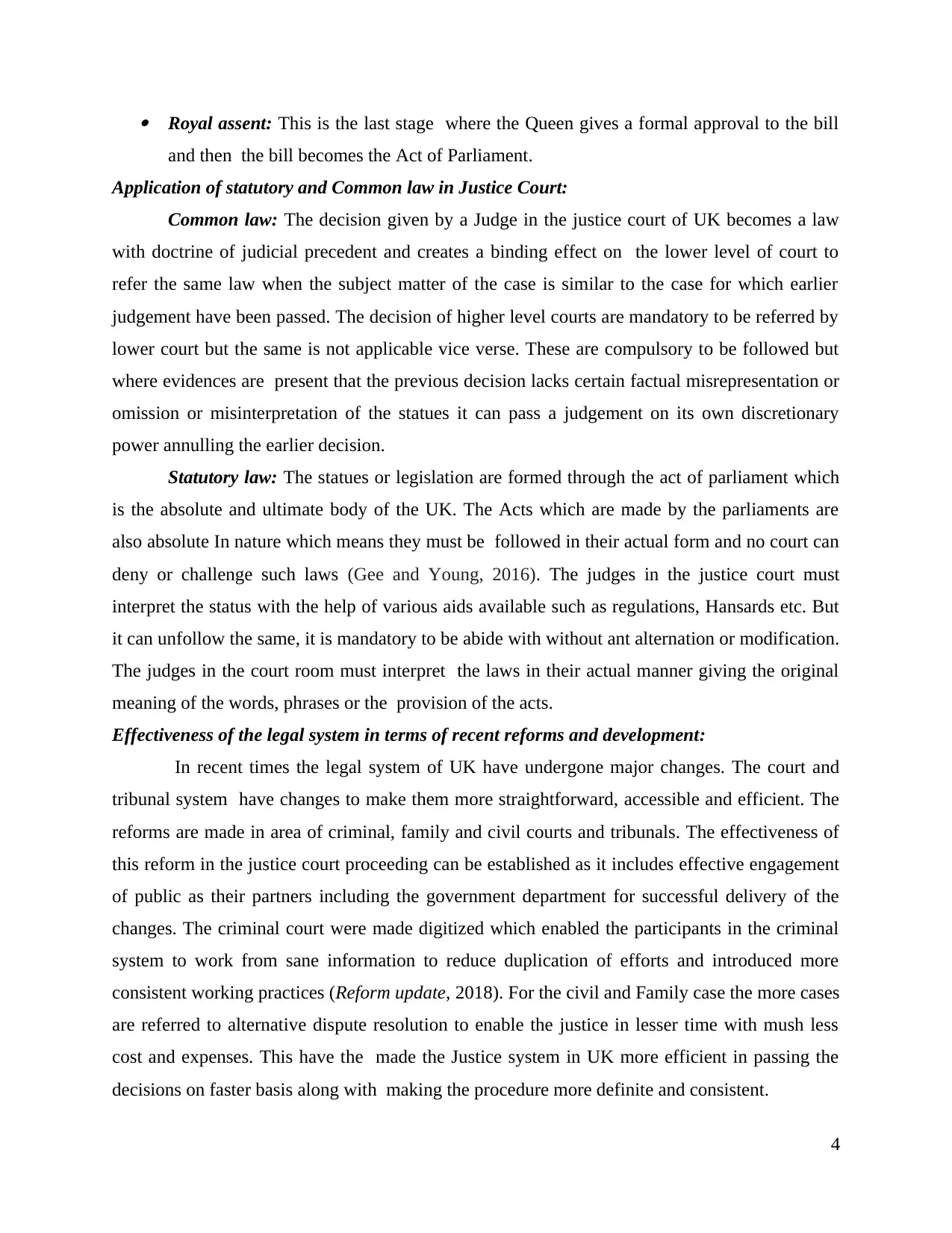
Royal assent: This is the last stage where the Queen gives a formal approval to the bill
and then the bill becomes the Act of Parliament.
Application of statutory and Common law in Justice Court:
Common law: The decision given by a Judge in the justice court of UK becomes a law
with doctrine of judicial precedent and creates a binding effect on the lower level of court to
refer the same law when the subject matter of the case is similar to the case for which earlier
judgement have been passed. The decision of higher level courts are mandatory to be referred by
lower court but the same is not applicable vice verse. These are compulsory to be followed but
where evidences are present that the previous decision lacks certain factual misrepresentation or
omission or misinterpretation of the statues it can pass a judgement on its own discretionary
power annulling the earlier decision.
Statutory law: The statues or legislation are formed through the act of parliament which
is the absolute and ultimate body of the UK. The Acts which are made by the parliaments are
also absolute In nature which means they must be followed in their actual form and no court can
deny or challenge such laws (Gee and Young, 2016). The judges in the justice court must
interpret the status with the help of various aids available such as regulations, Hansards etc. But
it can unfollow the same, it is mandatory to be abide with without ant alternation or modification.
The judges in the court room must interpret the laws in their actual manner giving the original
meaning of the words, phrases or the provision of the acts.
Effectiveness of the legal system in terms of recent reforms and development:
In recent times the legal system of UK have undergone major changes. The court and
tribunal system have changes to make them more straightforward, accessible and efficient. The
reforms are made in area of criminal, family and civil courts and tribunals. The effectiveness of
this reform in the justice court proceeding can be established as it includes effective engagement
of public as their partners including the government department for successful delivery of the
changes. The criminal court were made digitized which enabled the participants in the criminal
system to work from sane information to reduce duplication of efforts and introduced more
consistent working practices (Reform update, 2018). For the civil and Family case the more cases
are referred to alternative dispute resolution to enable the justice in lesser time with mush less
cost and expenses. This have the made the Justice system in UK more efficient in passing the
decisions on faster basis along with making the procedure more definite and consistent.
4
and then the bill becomes the Act of Parliament.
Application of statutory and Common law in Justice Court:
Common law: The decision given by a Judge in the justice court of UK becomes a law
with doctrine of judicial precedent and creates a binding effect on the lower level of court to
refer the same law when the subject matter of the case is similar to the case for which earlier
judgement have been passed. The decision of higher level courts are mandatory to be referred by
lower court but the same is not applicable vice verse. These are compulsory to be followed but
where evidences are present that the previous decision lacks certain factual misrepresentation or
omission or misinterpretation of the statues it can pass a judgement on its own discretionary
power annulling the earlier decision.
Statutory law: The statues or legislation are formed through the act of parliament which
is the absolute and ultimate body of the UK. The Acts which are made by the parliaments are
also absolute In nature which means they must be followed in their actual form and no court can
deny or challenge such laws (Gee and Young, 2016). The judges in the justice court must
interpret the status with the help of various aids available such as regulations, Hansards etc. But
it can unfollow the same, it is mandatory to be abide with without ant alternation or modification.
The judges in the court room must interpret the laws in their actual manner giving the original
meaning of the words, phrases or the provision of the acts.
Effectiveness of the legal system in terms of recent reforms and development:
In recent times the legal system of UK have undergone major changes. The court and
tribunal system have changes to make them more straightforward, accessible and efficient. The
reforms are made in area of criminal, family and civil courts and tribunals. The effectiveness of
this reform in the justice court proceeding can be established as it includes effective engagement
of public as their partners including the government department for successful delivery of the
changes. The criminal court were made digitized which enabled the participants in the criminal
system to work from sane information to reduce duplication of efforts and introduced more
consistent working practices (Reform update, 2018). For the civil and Family case the more cases
are referred to alternative dispute resolution to enable the justice in lesser time with mush less
cost and expenses. This have the made the Justice system in UK more efficient in passing the
decisions on faster basis along with making the procedure more definite and consistent.
4
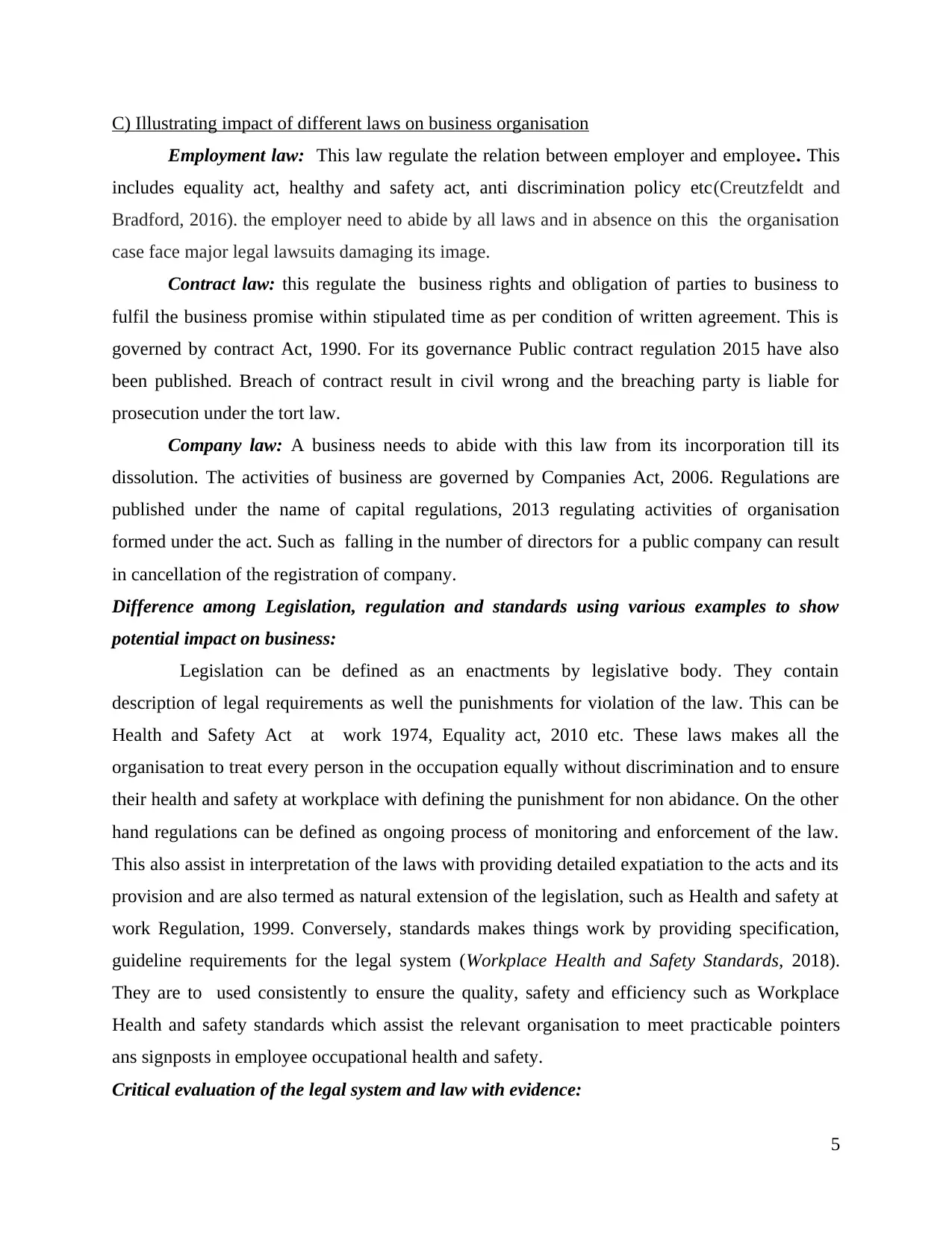
C) Illustrating impact of different laws on business organisation
Employment law: This law regulate the relation between employer and employee. This
includes equality act, healthy and safety act, anti discrimination policy etc(Creutzfeldt and
Bradford, 2016). the employer need to abide by all laws and in absence on this the organisation
case face major legal lawsuits damaging its image.
Contract law: this regulate the business rights and obligation of parties to business to
fulfil the business promise within stipulated time as per condition of written agreement. This is
governed by contract Act, 1990. For its governance Public contract regulation 2015 have also
been published. Breach of contract result in civil wrong and the breaching party is liable for
prosecution under the tort law.
Company law: A business needs to abide with this law from its incorporation till its
dissolution. The activities of business are governed by Companies Act, 2006. Regulations are
published under the name of capital regulations, 2013 regulating activities of organisation
formed under the act. Such as falling in the number of directors for a public company can result
in cancellation of the registration of company.
Difference among Legislation, regulation and standards using various examples to show
potential impact on business:
Legislation can be defined as an enactments by legislative body. They contain
description of legal requirements as well the punishments for violation of the law. This can be
Health and Safety Act at work 1974, Equality act, 2010 etc. These laws makes all the
organisation to treat every person in the occupation equally without discrimination and to ensure
their health and safety at workplace with defining the punishment for non abidance. On the other
hand regulations can be defined as ongoing process of monitoring and enforcement of the law.
This also assist in interpretation of the laws with providing detailed expatiation to the acts and its
provision and are also termed as natural extension of the legislation, such as Health and safety at
work Regulation, 1999. Conversely, standards makes things work by providing specification,
guideline requirements for the legal system (Workplace Health and Safety Standards, 2018).
They are to used consistently to ensure the quality, safety and efficiency such as Workplace
Health and safety standards which assist the relevant organisation to meet practicable pointers
ans signposts in employee occupational health and safety.
Critical evaluation of the legal system and law with evidence:
5
Employment law: This law regulate the relation between employer and employee. This
includes equality act, healthy and safety act, anti discrimination policy etc(Creutzfeldt and
Bradford, 2016). the employer need to abide by all laws and in absence on this the organisation
case face major legal lawsuits damaging its image.
Contract law: this regulate the business rights and obligation of parties to business to
fulfil the business promise within stipulated time as per condition of written agreement. This is
governed by contract Act, 1990. For its governance Public contract regulation 2015 have also
been published. Breach of contract result in civil wrong and the breaching party is liable for
prosecution under the tort law.
Company law: A business needs to abide with this law from its incorporation till its
dissolution. The activities of business are governed by Companies Act, 2006. Regulations are
published under the name of capital regulations, 2013 regulating activities of organisation
formed under the act. Such as falling in the number of directors for a public company can result
in cancellation of the registration of company.
Difference among Legislation, regulation and standards using various examples to show
potential impact on business:
Legislation can be defined as an enactments by legislative body. They contain
description of legal requirements as well the punishments for violation of the law. This can be
Health and Safety Act at work 1974, Equality act, 2010 etc. These laws makes all the
organisation to treat every person in the occupation equally without discrimination and to ensure
their health and safety at workplace with defining the punishment for non abidance. On the other
hand regulations can be defined as ongoing process of monitoring and enforcement of the law.
This also assist in interpretation of the laws with providing detailed expatiation to the acts and its
provision and are also termed as natural extension of the legislation, such as Health and safety at
work Regulation, 1999. Conversely, standards makes things work by providing specification,
guideline requirements for the legal system (Workplace Health and Safety Standards, 2018).
They are to used consistently to ensure the quality, safety and efficiency such as Workplace
Health and safety standards which assist the relevant organisation to meet practicable pointers
ans signposts in employee occupational health and safety.
Critical evaluation of the legal system and law with evidence:
5
Paraphrase This Document
Need a fresh take? Get an instant paraphrase of this document with our AI Paraphraser
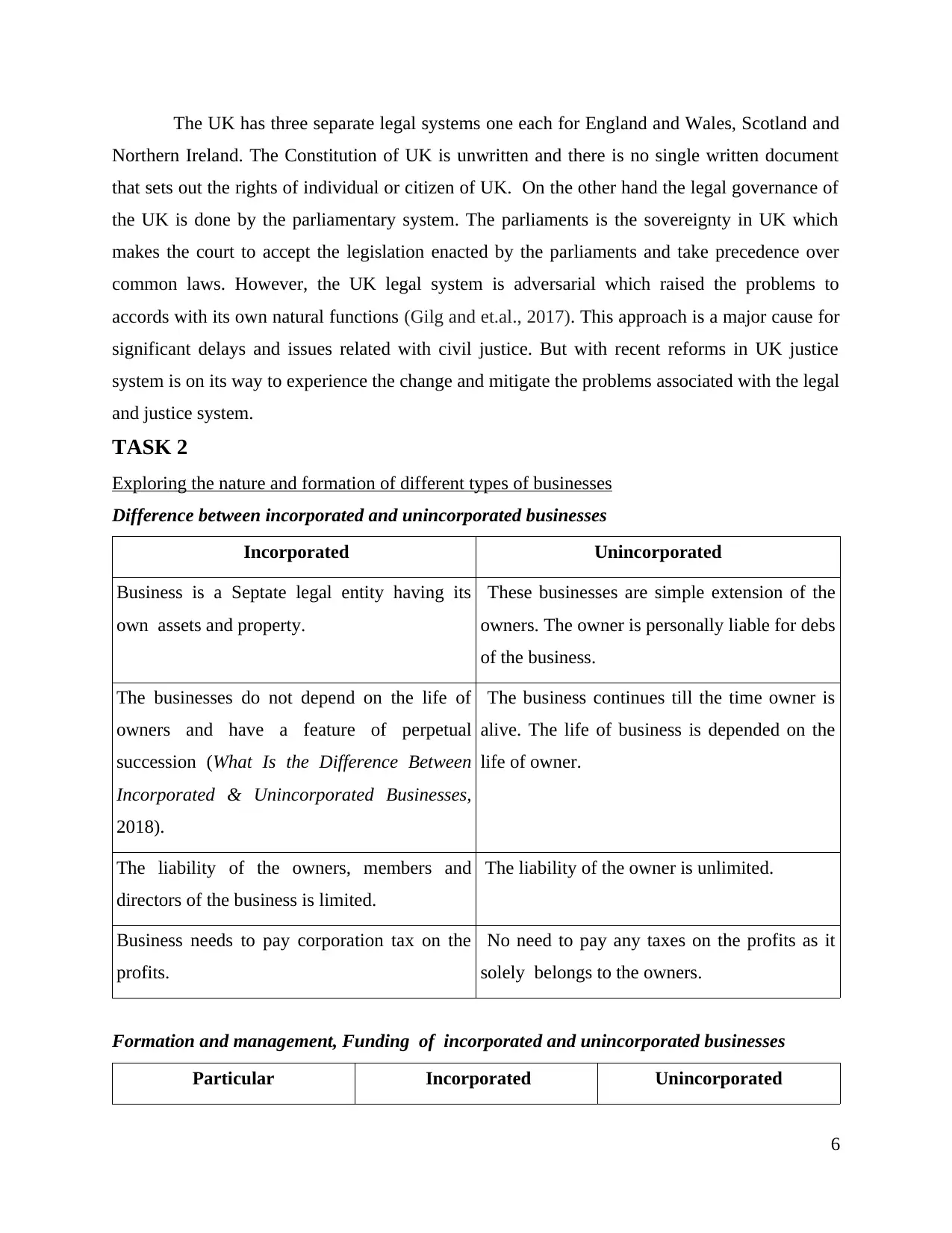
The UK has three separate legal systems one each for England and Wales, Scotland and
Northern Ireland. The Constitution of UK is unwritten and there is no single written document
that sets out the rights of individual or citizen of UK. On the other hand the legal governance of
the UK is done by the parliamentary system. The parliaments is the sovereignty in UK which
makes the court to accept the legislation enacted by the parliaments and take precedence over
common laws. However, the UK legal system is adversarial which raised the problems to
accords with its own natural functions (Gilg and et.al., 2017). This approach is a major cause for
significant delays and issues related with civil justice. But with recent reforms in UK justice
system is on its way to experience the change and mitigate the problems associated with the legal
and justice system.
TASK 2
Exploring the nature and formation of different types of businesses
Difference between incorporated and unincorporated businesses
Incorporated Unincorporated
Business is a Septate legal entity having its
own assets and property.
These businesses are simple extension of the
owners. The owner is personally liable for debs
of the business.
The businesses do not depend on the life of
owners and have a feature of perpetual
succession (What Is the Difference Between
Incorporated & Unincorporated Businesses,
2018).
The business continues till the time owner is
alive. The life of business is depended on the
life of owner.
The liability of the owners, members and
directors of the business is limited.
The liability of the owner is unlimited.
Business needs to pay corporation tax on the
profits.
No need to pay any taxes on the profits as it
solely belongs to the owners.
Formation and management, Funding of incorporated and unincorporated businesses
Particular Incorporated Unincorporated
6
Northern Ireland. The Constitution of UK is unwritten and there is no single written document
that sets out the rights of individual or citizen of UK. On the other hand the legal governance of
the UK is done by the parliamentary system. The parliaments is the sovereignty in UK which
makes the court to accept the legislation enacted by the parliaments and take precedence over
common laws. However, the UK legal system is adversarial which raised the problems to
accords with its own natural functions (Gilg and et.al., 2017). This approach is a major cause for
significant delays and issues related with civil justice. But with recent reforms in UK justice
system is on its way to experience the change and mitigate the problems associated with the legal
and justice system.
TASK 2
Exploring the nature and formation of different types of businesses
Difference between incorporated and unincorporated businesses
Incorporated Unincorporated
Business is a Septate legal entity having its
own assets and property.
These businesses are simple extension of the
owners. The owner is personally liable for debs
of the business.
The businesses do not depend on the life of
owners and have a feature of perpetual
succession (What Is the Difference Between
Incorporated & Unincorporated Businesses,
2018).
The business continues till the time owner is
alive. The life of business is depended on the
life of owner.
The liability of the owners, members and
directors of the business is limited.
The liability of the owner is unlimited.
Business needs to pay corporation tax on the
profits.
No need to pay any taxes on the profits as it
solely belongs to the owners.
Formation and management, Funding of incorporated and unincorporated businesses
Particular Incorporated Unincorporated
6
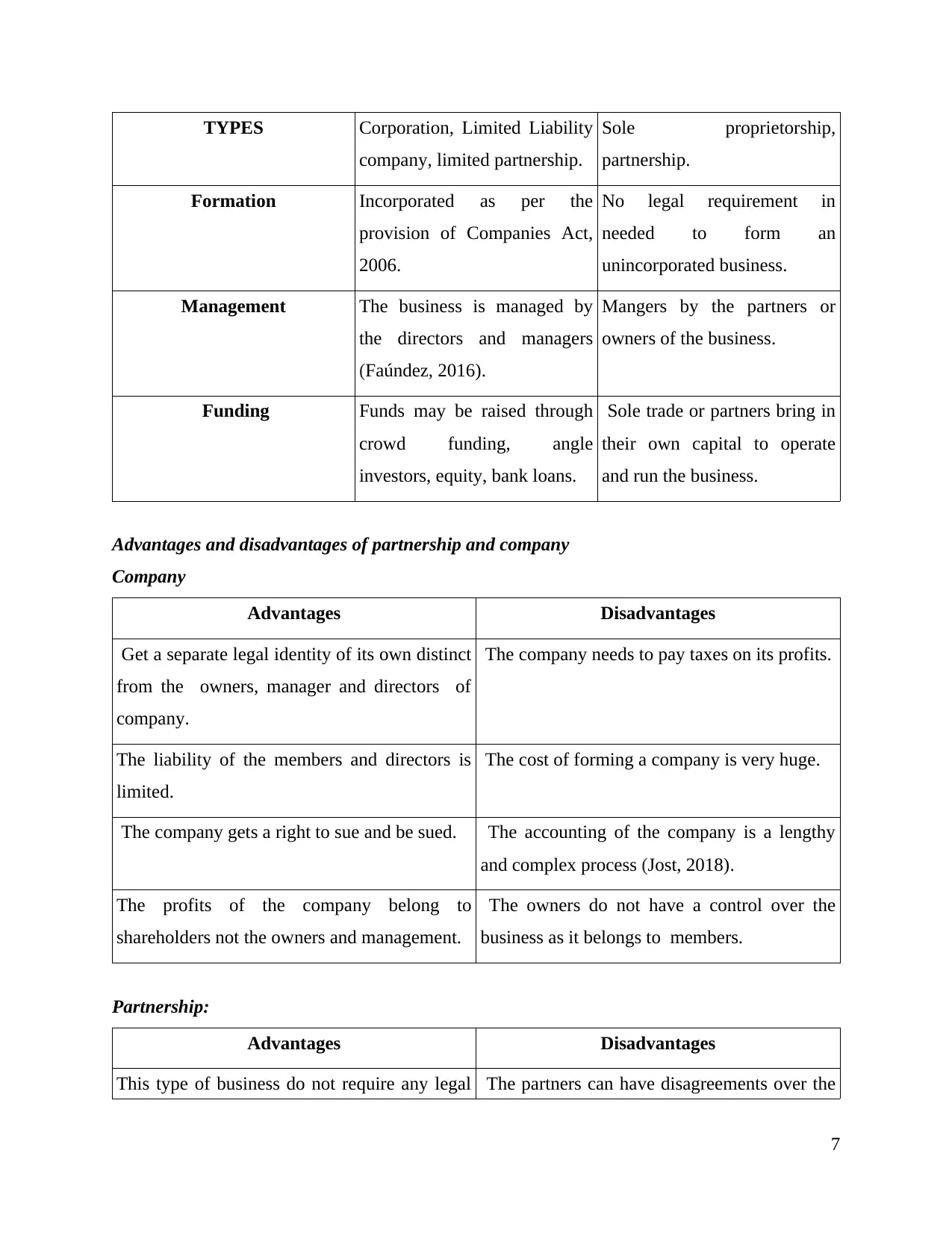
TYPES Corporation, Limited Liability
company, limited partnership.
Sole proprietorship,
partnership.
Formation Incorporated as per the
provision of Companies Act,
2006.
No legal requirement in
needed to form an
unincorporated business.
Management The business is managed by
the directors and managers
(Faúndez, 2016).
Mangers by the partners or
owners of the business.
Funding Funds may be raised through
crowd funding, angle
investors, equity, bank loans.
Sole trade or partners bring in
their own capital to operate
and run the business.
Advantages and disadvantages of partnership and company
Company
Advantages Disadvantages
Get a separate legal identity of its own distinct
from the owners, manager and directors of
company.
The company needs to pay taxes on its profits.
The liability of the members and directors is
limited.
The cost of forming a company is very huge.
The company gets a right to sue and be sued. The accounting of the company is a lengthy
and complex process (Jost, 2018).
The profits of the company belong to
shareholders not the owners and management.
The owners do not have a control over the
business as it belongs to members.
Partnership:
Advantages Disadvantages
This type of business do not require any legal The partners can have disagreements over the
7
company, limited partnership.
Sole proprietorship,
partnership.
Formation Incorporated as per the
provision of Companies Act,
2006.
No legal requirement in
needed to form an
unincorporated business.
Management The business is managed by
the directors and managers
(Faúndez, 2016).
Mangers by the partners or
owners of the business.
Funding Funds may be raised through
crowd funding, angle
investors, equity, bank loans.
Sole trade or partners bring in
their own capital to operate
and run the business.
Advantages and disadvantages of partnership and company
Company
Advantages Disadvantages
Get a separate legal identity of its own distinct
from the owners, manager and directors of
company.
The company needs to pay taxes on its profits.
The liability of the members and directors is
limited.
The cost of forming a company is very huge.
The company gets a right to sue and be sued. The accounting of the company is a lengthy
and complex process (Jost, 2018).
The profits of the company belong to
shareholders not the owners and management.
The owners do not have a control over the
business as it belongs to members.
Partnership:
Advantages Disadvantages
This type of business do not require any legal The partners can have disagreements over the
7
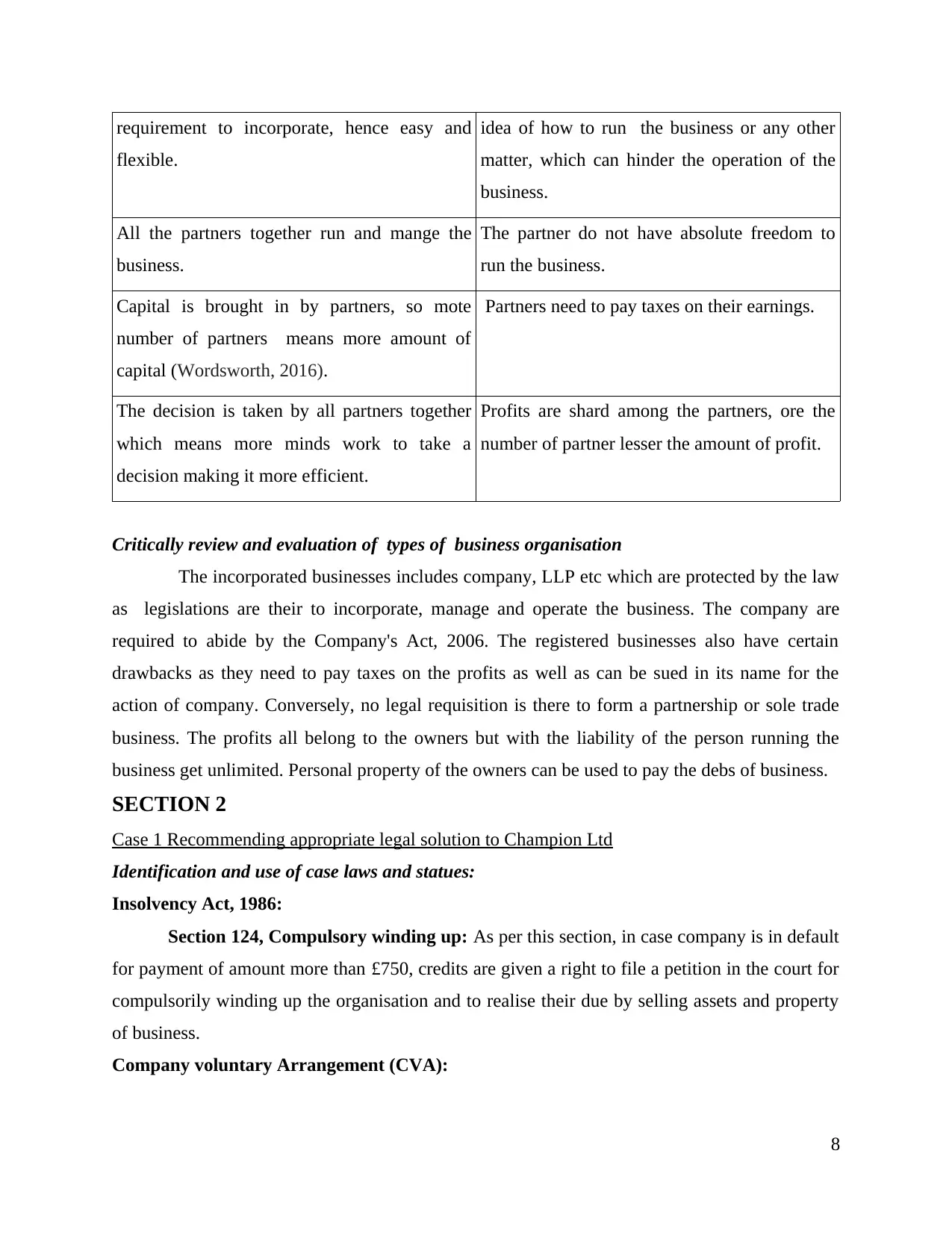
requirement to incorporate, hence easy and
flexible.
idea of how to run the business or any other
matter, which can hinder the operation of the
business.
All the partners together run and mange the
business.
The partner do not have absolute freedom to
run the business.
Capital is brought in by partners, so mote
number of partners means more amount of
capital (Wordsworth, 2016).
Partners need to pay taxes on their earnings.
The decision is taken by all partners together
which means more minds work to take a
decision making it more efficient.
Profits are shard among the partners, ore the
number of partner lesser the amount of profit.
Critically review and evaluation of types of business organisation
The incorporated businesses includes company, LLP etc which are protected by the law
as legislations are their to incorporate, manage and operate the business. The company are
required to abide by the Company's Act, 2006. The registered businesses also have certain
drawbacks as they need to pay taxes on the profits as well as can be sued in its name for the
action of company. Conversely, no legal requisition is there to form a partnership or sole trade
business. The profits all belong to the owners but with the liability of the person running the
business get unlimited. Personal property of the owners can be used to pay the debs of business.
SECTION 2
Case 1 Recommending appropriate legal solution to Champion Ltd
Identification and use of case laws and statues:
Insolvency Act, 1986:
Section 124, Compulsory winding up: As per this section, in case company is in default
for payment of amount more than £750, credits are given a right to file a petition in the court for
compulsorily winding up the organisation and to realise their due by selling assets and property
of business.
Company voluntary Arrangement (CVA):
8
flexible.
idea of how to run the business or any other
matter, which can hinder the operation of the
business.
All the partners together run and mange the
business.
The partner do not have absolute freedom to
run the business.
Capital is brought in by partners, so mote
number of partners means more amount of
capital (Wordsworth, 2016).
Partners need to pay taxes on their earnings.
The decision is taken by all partners together
which means more minds work to take a
decision making it more efficient.
Profits are shard among the partners, ore the
number of partner lesser the amount of profit.
Critically review and evaluation of types of business organisation
The incorporated businesses includes company, LLP etc which are protected by the law
as legislations are their to incorporate, manage and operate the business. The company are
required to abide by the Company's Act, 2006. The registered businesses also have certain
drawbacks as they need to pay taxes on the profits as well as can be sued in its name for the
action of company. Conversely, no legal requisition is there to form a partnership or sole trade
business. The profits all belong to the owners but with the liability of the person running the
business get unlimited. Personal property of the owners can be used to pay the debs of business.
SECTION 2
Case 1 Recommending appropriate legal solution to Champion Ltd
Identification and use of case laws and statues:
Insolvency Act, 1986:
Section 124, Compulsory winding up: As per this section, in case company is in default
for payment of amount more than £750, credits are given a right to file a petition in the court for
compulsorily winding up the organisation and to realise their due by selling assets and property
of business.
Company voluntary Arrangement (CVA):
8
Secure Best Marks with AI Grader
Need help grading? Try our AI Grader for instant feedback on your assignments.
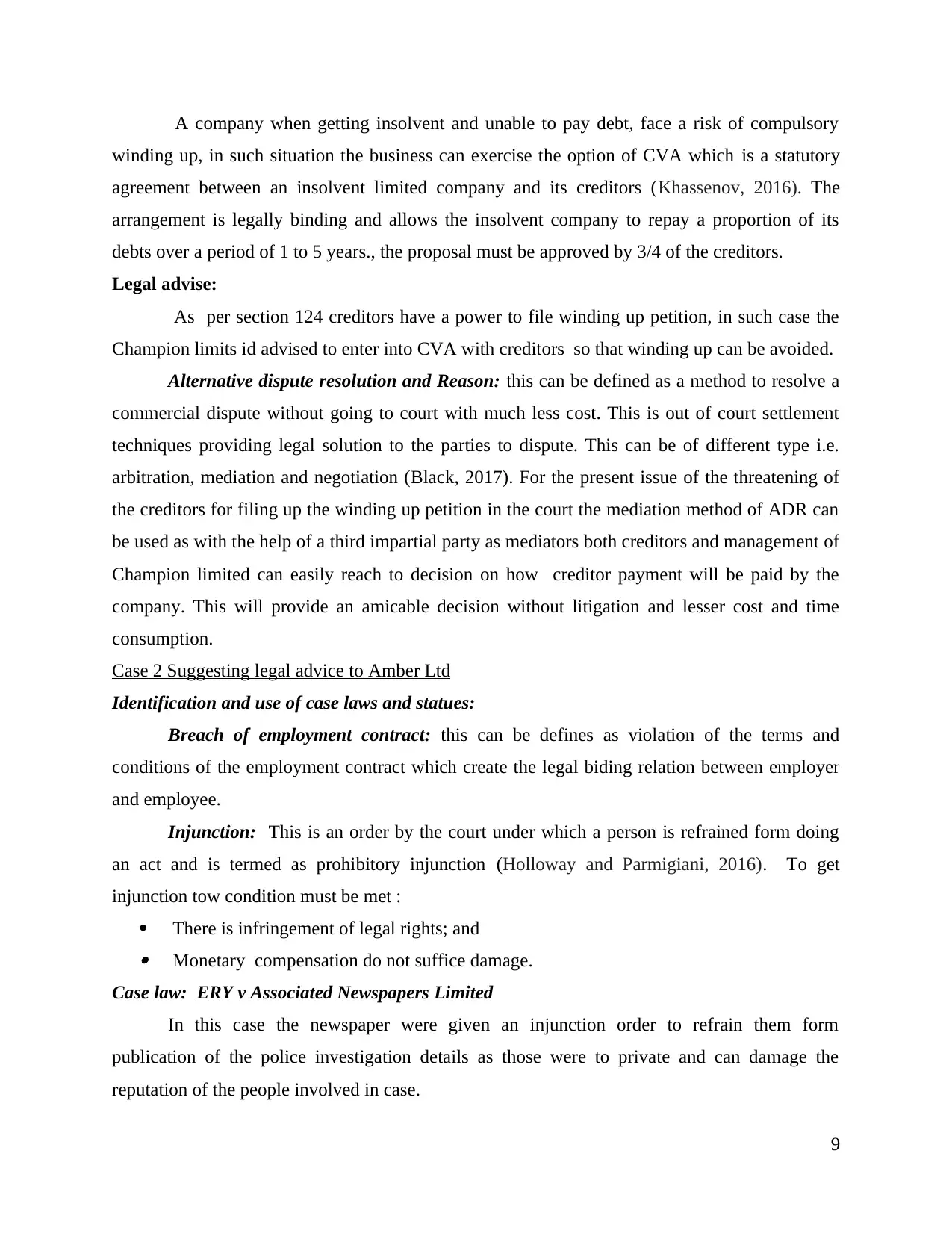
A company when getting insolvent and unable to pay debt, face a risk of compulsory
winding up, in such situation the business can exercise the option of CVA which is a statutory
agreement between an insolvent limited company and its creditors (Khassenov, 2016). The
arrangement is legally binding and allows the insolvent company to repay a proportion of its
debts over a period of 1 to 5 years., the proposal must be approved by 3/4 of the creditors.
Legal advise:
As per section 124 creditors have a power to file winding up petition, in such case the
Champion limits id advised to enter into CVA with creditors so that winding up can be avoided.
Alternative dispute resolution and Reason: this can be defined as a method to resolve a
commercial dispute without going to court with much less cost. This is out of court settlement
techniques providing legal solution to the parties to dispute. This can be of different type i.e.
arbitration, mediation and negotiation (Black, 2017). For the present issue of the threatening of
the creditors for filing up the winding up petition in the court the mediation method of ADR can
be used as with the help of a third impartial party as mediators both creditors and management of
Champion limited can easily reach to decision on how creditor payment will be paid by the
company. This will provide an amicable decision without litigation and lesser cost and time
consumption.
Case 2 Suggesting legal advice to Amber Ltd
Identification and use of case laws and statues:
Breach of employment contract: this can be defines as violation of the terms and
conditions of the employment contract which create the legal biding relation between employer
and employee.
Injunction: This is an order by the court under which a person is refrained form doing
an act and is termed as prohibitory injunction (Holloway and Parmigiani, 2016). To get
injunction tow condition must be met :
There is infringement of legal rights; and Monetary compensation do not suffice damage.
Case law: ERY v Associated Newspapers Limited
In this case the newspaper were given an injunction order to refrain them form
publication of the police investigation details as those were to private and can damage the
reputation of the people involved in case.
9
winding up, in such situation the business can exercise the option of CVA which is a statutory
agreement between an insolvent limited company and its creditors (Khassenov, 2016). The
arrangement is legally binding and allows the insolvent company to repay a proportion of its
debts over a period of 1 to 5 years., the proposal must be approved by 3/4 of the creditors.
Legal advise:
As per section 124 creditors have a power to file winding up petition, in such case the
Champion limits id advised to enter into CVA with creditors so that winding up can be avoided.
Alternative dispute resolution and Reason: this can be defined as a method to resolve a
commercial dispute without going to court with much less cost. This is out of court settlement
techniques providing legal solution to the parties to dispute. This can be of different type i.e.
arbitration, mediation and negotiation (Black, 2017). For the present issue of the threatening of
the creditors for filing up the winding up petition in the court the mediation method of ADR can
be used as with the help of a third impartial party as mediators both creditors and management of
Champion limited can easily reach to decision on how creditor payment will be paid by the
company. This will provide an amicable decision without litigation and lesser cost and time
consumption.
Case 2 Suggesting legal advice to Amber Ltd
Identification and use of case laws and statues:
Breach of employment contract: this can be defines as violation of the terms and
conditions of the employment contract which create the legal biding relation between employer
and employee.
Injunction: This is an order by the court under which a person is refrained form doing
an act and is termed as prohibitory injunction (Holloway and Parmigiani, 2016). To get
injunction tow condition must be met :
There is infringement of legal rights; and Monetary compensation do not suffice damage.
Case law: ERY v Associated Newspapers Limited
In this case the newspaper were given an injunction order to refrain them form
publication of the police investigation details as those were to private and can damage the
reputation of the people involved in case.
9
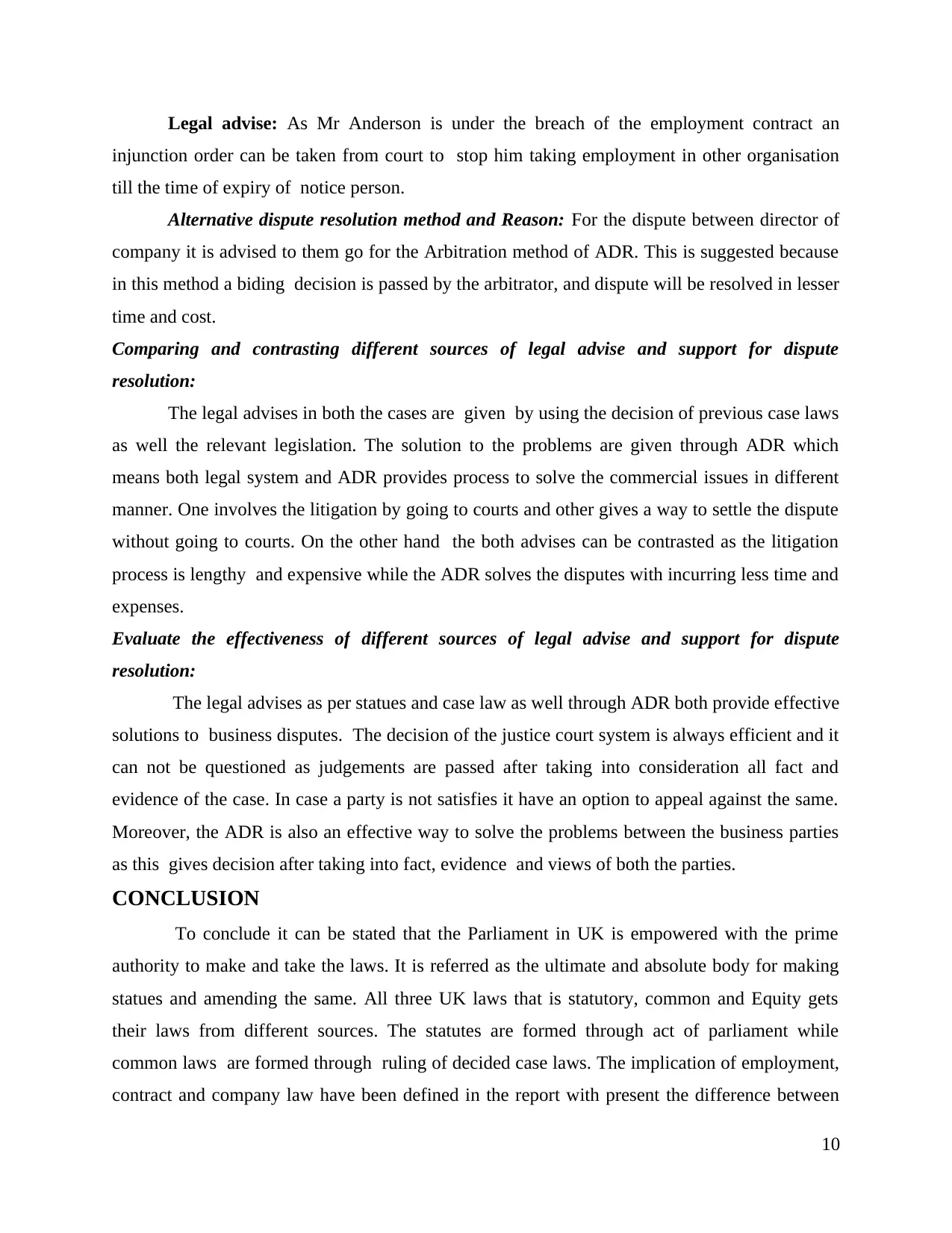
Legal advise: As Mr Anderson is under the breach of the employment contract an
injunction order can be taken from court to stop him taking employment in other organisation
till the time of expiry of notice person.
Alternative dispute resolution method and Reason: For the dispute between director of
company it is advised to them go for the Arbitration method of ADR. This is suggested because
in this method a biding decision is passed by the arbitrator, and dispute will be resolved in lesser
time and cost.
Comparing and contrasting different sources of legal advise and support for dispute
resolution:
The legal advises in both the cases are given by using the decision of previous case laws
as well the relevant legislation. The solution to the problems are given through ADR which
means both legal system and ADR provides process to solve the commercial issues in different
manner. One involves the litigation by going to courts and other gives a way to settle the dispute
without going to courts. On the other hand the both advises can be contrasted as the litigation
process is lengthy and expensive while the ADR solves the disputes with incurring less time and
expenses.
Evaluate the effectiveness of different sources of legal advise and support for dispute
resolution:
The legal advises as per statues and case law as well through ADR both provide effective
solutions to business disputes. The decision of the justice court system is always efficient and it
can not be questioned as judgements are passed after taking into consideration all fact and
evidence of the case. In case a party is not satisfies it have an option to appeal against the same.
Moreover, the ADR is also an effective way to solve the problems between the business parties
as this gives decision after taking into fact, evidence and views of both the parties.
CONCLUSION
To conclude it can be stated that the Parliament in UK is empowered with the prime
authority to make and take the laws. It is referred as the ultimate and absolute body for making
statues and amending the same. All three UK laws that is statutory, common and Equity gets
their laws from different sources. The statutes are formed through act of parliament while
common laws are formed through ruling of decided case laws. The implication of employment,
contract and company law have been defined in the report with present the difference between
10
injunction order can be taken from court to stop him taking employment in other organisation
till the time of expiry of notice person.
Alternative dispute resolution method and Reason: For the dispute between director of
company it is advised to them go for the Arbitration method of ADR. This is suggested because
in this method a biding decision is passed by the arbitrator, and dispute will be resolved in lesser
time and cost.
Comparing and contrasting different sources of legal advise and support for dispute
resolution:
The legal advises in both the cases are given by using the decision of previous case laws
as well the relevant legislation. The solution to the problems are given through ADR which
means both legal system and ADR provides process to solve the commercial issues in different
manner. One involves the litigation by going to courts and other gives a way to settle the dispute
without going to courts. On the other hand the both advises can be contrasted as the litigation
process is lengthy and expensive while the ADR solves the disputes with incurring less time and
expenses.
Evaluate the effectiveness of different sources of legal advise and support for dispute
resolution:
The legal advises as per statues and case law as well through ADR both provide effective
solutions to business disputes. The decision of the justice court system is always efficient and it
can not be questioned as judgements are passed after taking into consideration all fact and
evidence of the case. In case a party is not satisfies it have an option to appeal against the same.
Moreover, the ADR is also an effective way to solve the problems between the business parties
as this gives decision after taking into fact, evidence and views of both the parties.
CONCLUSION
To conclude it can be stated that the Parliament in UK is empowered with the prime
authority to make and take the laws. It is referred as the ultimate and absolute body for making
statues and amending the same. All three UK laws that is statutory, common and Equity gets
their laws from different sources. The statutes are formed through act of parliament while
common laws are formed through ruling of decided case laws. The implication of employment,
contract and company law have been defined in the report with present the difference between
10
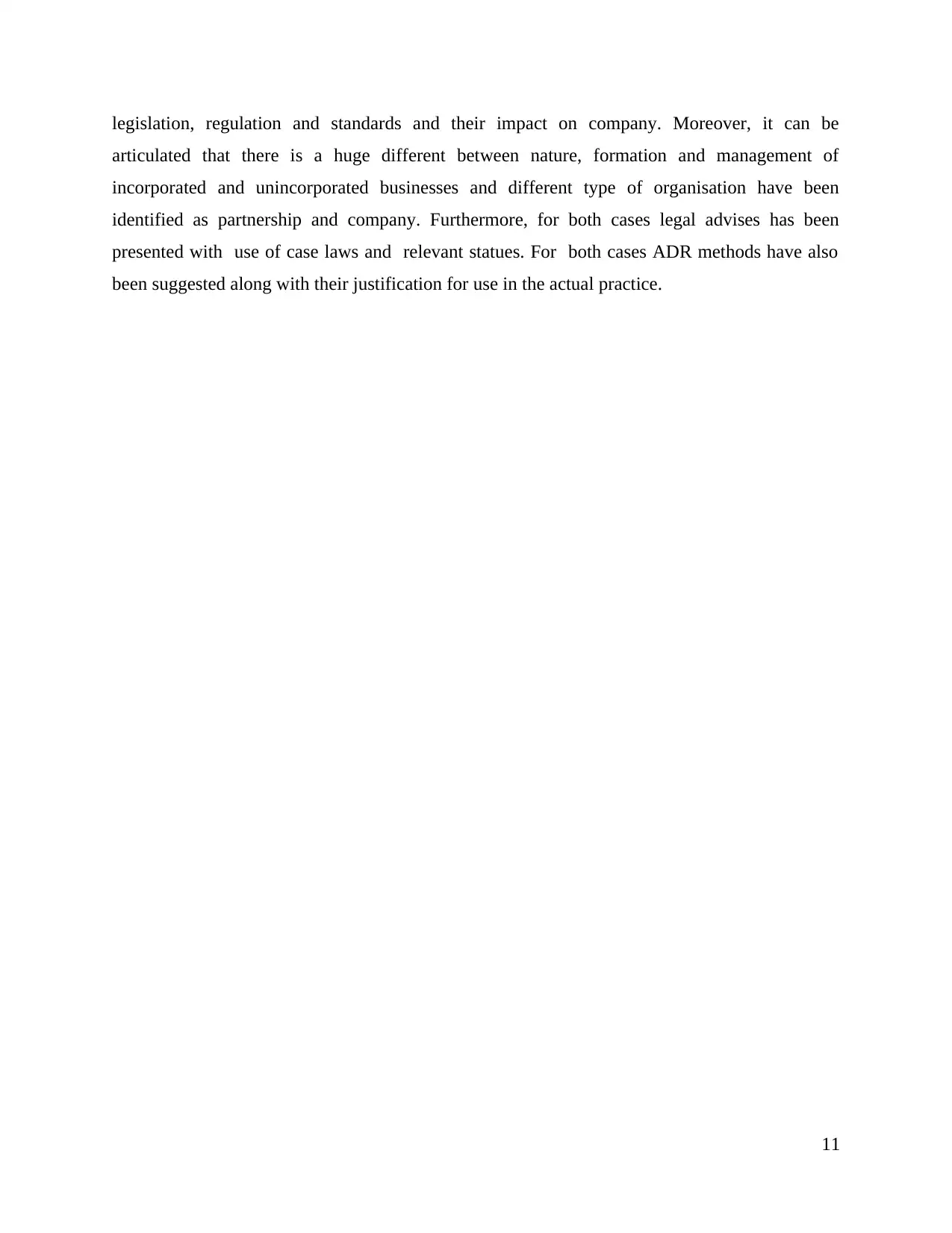
legislation, regulation and standards and their impact on company. Moreover, it can be
articulated that there is a huge different between nature, formation and management of
incorporated and unincorporated businesses and different type of organisation have been
identified as partnership and company. Furthermore, for both cases legal advises has been
presented with use of case laws and relevant statues. For both cases ADR methods have also
been suggested along with their justification for use in the actual practice.
11
articulated that there is a huge different between nature, formation and management of
incorporated and unincorporated businesses and different type of organisation have been
identified as partnership and company. Furthermore, for both cases legal advises has been
presented with use of case laws and relevant statues. For both cases ADR methods have also
been suggested along with their justification for use in the actual practice.
11
Paraphrase This Document
Need a fresh take? Get an instant paraphrase of this document with our AI Paraphraser
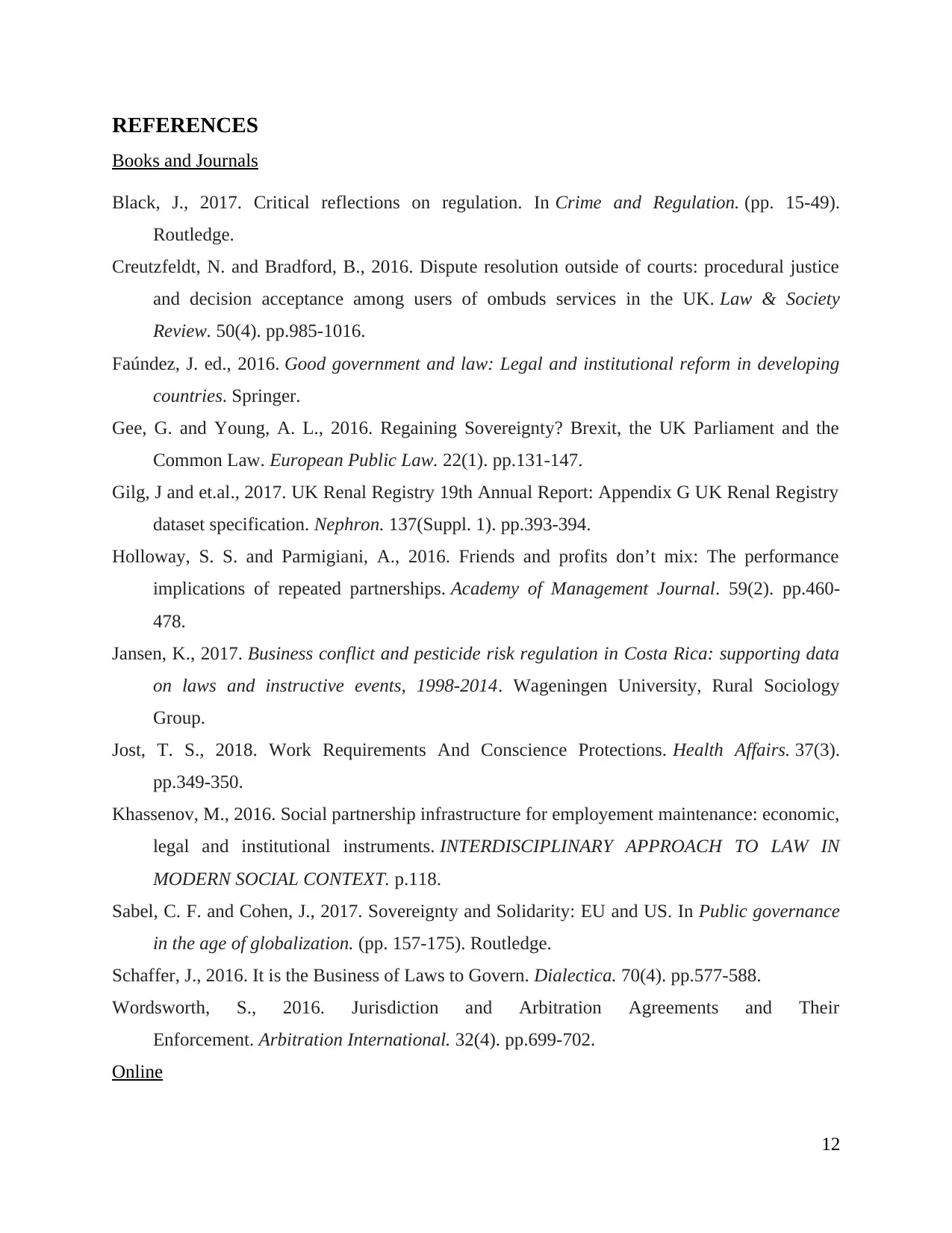
REFERENCES
Books and Journals
Black, J., 2017. Critical reflections on regulation. In Crime and Regulation. (pp. 15-49).
Routledge.
Creutzfeldt, N. and Bradford, B., 2016. Dispute resolution outside of courts: procedural justice
and decision acceptance among users of ombuds services in the UK. Law & Society
Review. 50(4). pp.985-1016.
Faúndez, J. ed., 2016. Good government and law: Legal and institutional reform in developing
countries. Springer.
Gee, G. and Young, A. L., 2016. Regaining Sovereignty? Brexit, the UK Parliament and the
Common Law. European Public Law. 22(1). pp.131-147.
Gilg, J and et.al., 2017. UK Renal Registry 19th Annual Report: Appendix G UK Renal Registry
dataset specification. Nephron. 137(Suppl. 1). pp.393-394.
Holloway, S. S. and Parmigiani, A., 2016. Friends and profits don’t mix: The performance
implications of repeated partnerships. Academy of Management Journal. 59(2). pp.460-
478.
Jansen, K., 2017. Business conflict and pesticide risk regulation in Costa Rica: supporting data
on laws and instructive events, 1998-2014. Wageningen University, Rural Sociology
Group.
Jost, T. S., 2018. Work Requirements And Conscience Protections. Health Affairs. 37(3).
pp.349-350.
Khassenov, M., 2016. Social partnership infrastructure for employement maintenance: economic,
legal and institutional instruments. INTERDISCIPLINARY APPROACH TO LAW IN
MODERN SOCIAL CONTEXT. p.118.
Sabel, C. F. and Cohen, J., 2017. Sovereignty and Solidarity: EU and US. In Public governance
in the age of globalization. (pp. 157-175). Routledge.
Schaffer, J., 2016. It is the Business of Laws to Govern. Dialectica. 70(4). pp.577-588.
Wordsworth, S., 2016. Jurisdiction and Arbitration Agreements and Their
Enforcement. Arbitration International. 32(4). pp.699-702.
Online
12
Books and Journals
Black, J., 2017. Critical reflections on regulation. In Crime and Regulation. (pp. 15-49).
Routledge.
Creutzfeldt, N. and Bradford, B., 2016. Dispute resolution outside of courts: procedural justice
and decision acceptance among users of ombuds services in the UK. Law & Society
Review. 50(4). pp.985-1016.
Faúndez, J. ed., 2016. Good government and law: Legal and institutional reform in developing
countries. Springer.
Gee, G. and Young, A. L., 2016. Regaining Sovereignty? Brexit, the UK Parliament and the
Common Law. European Public Law. 22(1). pp.131-147.
Gilg, J and et.al., 2017. UK Renal Registry 19th Annual Report: Appendix G UK Renal Registry
dataset specification. Nephron. 137(Suppl. 1). pp.393-394.
Holloway, S. S. and Parmigiani, A., 2016. Friends and profits don’t mix: The performance
implications of repeated partnerships. Academy of Management Journal. 59(2). pp.460-
478.
Jansen, K., 2017. Business conflict and pesticide risk regulation in Costa Rica: supporting data
on laws and instructive events, 1998-2014. Wageningen University, Rural Sociology
Group.
Jost, T. S., 2018. Work Requirements And Conscience Protections. Health Affairs. 37(3).
pp.349-350.
Khassenov, M., 2016. Social partnership infrastructure for employement maintenance: economic,
legal and institutional instruments. INTERDISCIPLINARY APPROACH TO LAW IN
MODERN SOCIAL CONTEXT. p.118.
Sabel, C. F. and Cohen, J., 2017. Sovereignty and Solidarity: EU and US. In Public governance
in the age of globalization. (pp. 157-175). Routledge.
Schaffer, J., 2016. It is the Business of Laws to Govern. Dialectica. 70(4). pp.577-588.
Wordsworth, S., 2016. Jurisdiction and Arbitration Agreements and Their
Enforcement. Arbitration International. 32(4). pp.699-702.
Online
12
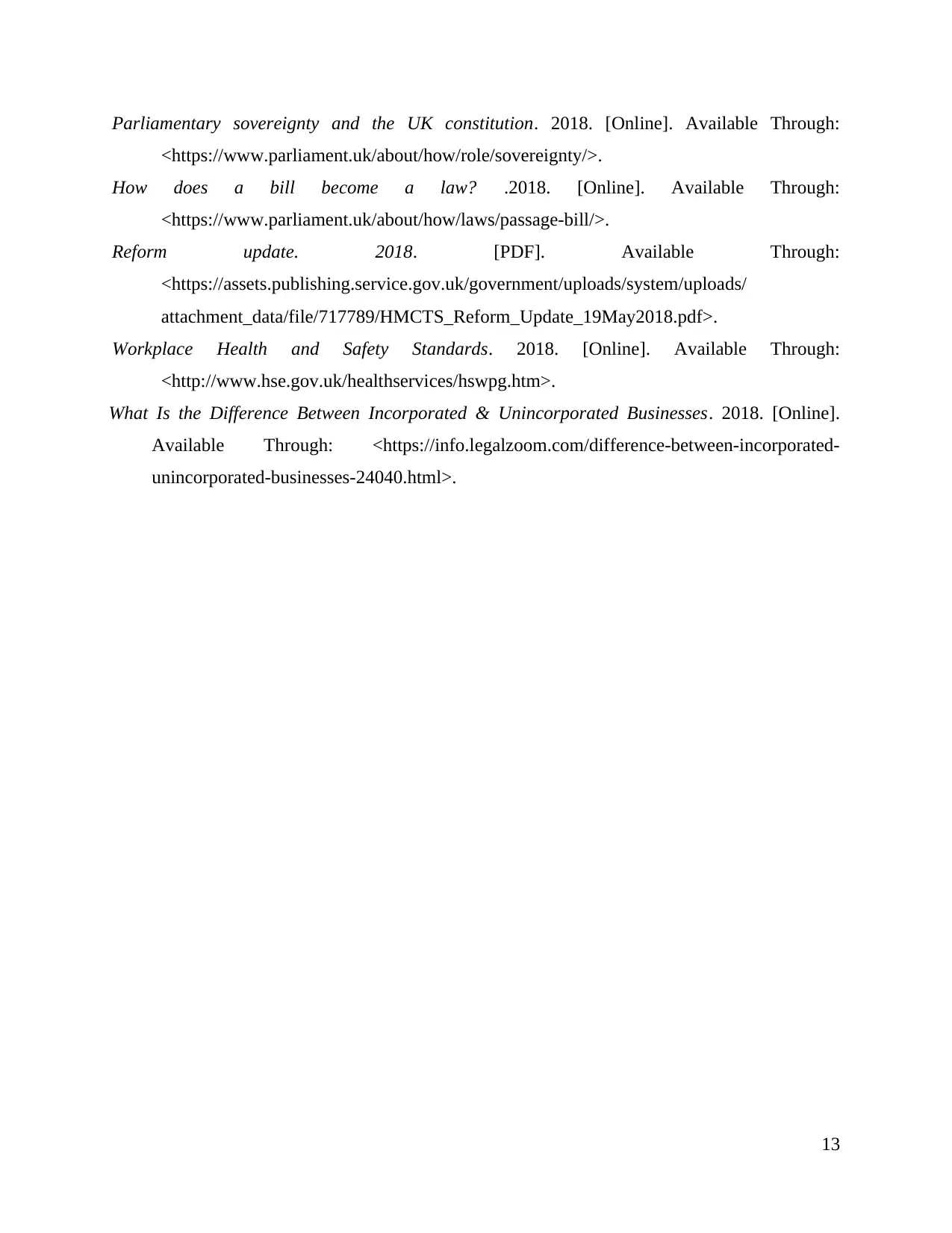
Parliamentary sovereignty and the UK constitution. 2018. [Online]. Available Through:
<https://www.parliament.uk/about/how/role/sovereignty/>.
How does a bill become a law? .2018. [Online]. Available Through:
<https://www.parliament.uk/about/how/laws/passage-bill/>.
Reform update. 2018. [PDF]. Available Through:
<https://assets.publishing.service.gov.uk/government/uploads/system/uploads/
attachment_data/file/717789/HMCTS_Reform_Update_19May2018.pdf>.
Workplace Health and Safety Standards. 2018. [Online]. Available Through:
<http://www.hse.gov.uk/healthservices/hswpg.htm>.
What Is the Difference Between Incorporated & Unincorporated Businesses. 2018. [Online].
Available Through: <https://info.legalzoom.com/difference-between-incorporated-
unincorporated-businesses-24040.html>.
13
<https://www.parliament.uk/about/how/role/sovereignty/>.
How does a bill become a law? .2018. [Online]. Available Through:
<https://www.parliament.uk/about/how/laws/passage-bill/>.
Reform update. 2018. [PDF]. Available Through:
<https://assets.publishing.service.gov.uk/government/uploads/system/uploads/
attachment_data/file/717789/HMCTS_Reform_Update_19May2018.pdf>.
Workplace Health and Safety Standards. 2018. [Online]. Available Through:
<http://www.hse.gov.uk/healthservices/hswpg.htm>.
What Is the Difference Between Incorporated & Unincorporated Businesses. 2018. [Online].
Available Through: <https://info.legalzoom.com/difference-between-incorporated-
unincorporated-businesses-24040.html>.
13
1 out of 15
Related Documents
Your All-in-One AI-Powered Toolkit for Academic Success.
+13062052269
info@desklib.com
Available 24*7 on WhatsApp / Email
![[object Object]](/_next/static/media/star-bottom.7253800d.svg)
Unlock your academic potential
© 2024 | Zucol Services PVT LTD | All rights reserved.





